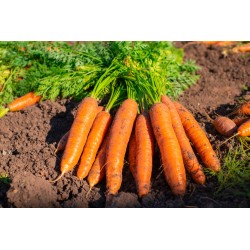



Carrot is a very British vegetable and Nantes is one of the best for winter storage. Carrots are rich in antioxidants and vitamin A. Roots are delicious raw when they are young and great for cooking in full maturity. Approximately 120 days from sowing. Our most popular carrot seed.
Site Prep
Carrots are a root crop which require deep soil so ensure the soil is softened to at least 10” deep or that your pot you are planting in is at least 12” deep. Compacted soil will result in forked, nubby carrots. Too much nitrogen in your soil will result in lots of leaves and little carrots, so be careful not to add to much compost or manure. Carrots do quite well in poor soils but additions such as bone meal, which helps root development are great. Making your soil slightly more alkaline through adding wood ash or horticultural lime is said to make your carrots extra tasty and also helps keep away soil born pests. Adding some sand makes for easy digging and can help prevent issues with soggy soils in wetter climates.
Sowing
Make a shallow trench, about ½” deep. Sprinkle the small carrot seeds quite generously into trench and cover. You will thin them later so don’t worry if it is not super uniform. Firm soil to remove air and water in well. If you are planting multiple rows, space rows at least 6” apart. This can be a great way to utilize space as a double or even triple row of carrots can easily be tended from one or either side.
Care
Especially when young, carrots will need watering every couple of days in the ground or every day in planters/pots. Watering should be done during the cooler hours of the day, in the morning or evening, so as not to shock the plants or lose all your watering work to the hot sun. As the carrots grow, they will get crowded. When they get about finger sized, thin about every second one to give space for the others to mature. These make great snacks and will also keep well in the refrigerator at this size.
Harvest
Carrots can be harvested at any size desired. You can often see the top of the root sticking out of the ground and judge how big it is, if it is unclear brush around the base of the leaves to expose some of the root or simply pull one out. It is often easiest to loosen the ground with a garden fork or by digging beside the row with a shovel. Often times just pulling on larger or crowded carrots causes breaking which you don’t want. They can even be left in the ground well into the fall and after the frost has killed the tops. Just be sure to pick them before the ground freezes. Make sure your harvest is air dried and washed, in that order, to keep the skins intact before storing. The drying and setting of the skins is known as curing and can greatly increase the storage life of your carrots.
Start-Ahead Method
Note: This is not recommended as any damage done to the roots of the carrot seedlings results in damage to the carrots. However, if done properly can be a great way to get some slightly earlier, albeit smaller carrots to snack on.
Soil
To start, it is best to use a fine potting mix that has been sterilized. If you cannot find a pre-sterilized mix, baking the soil on a metal tray for 30 minutes at 200 F will kill any mold spores or pathogens that could harm the seedlings. Adding sand or vermiculite for extra drainage is recommended. It is also usually helpful to add bone meal to seed starting mix to encourage healthy root development.
Sowing
Choose small pots or cell packs that will allow you to easily remove the transplants with minimal root disturbance when you are planting them out. Seed your carrots no more than 4 weeks in advance of planting out. Sprinkle the seeds, 5 or 6 to a cell, on top of the soil and sprinkle more soil over top to cover lightly. Water well.
Continuing Care
Let seedlings dry slightly between watering but avoid letting them wilt. Avoid chlorinated tap water, water can be filtered or left out overnight to allow the chlorine to dissipate. Do not worry about fertilizing you carrot seedlings as they will not be in their pots for long. If growing under a cover of any sort, be sure to slowly acclimate them to drier air as they grow so they do not wilt when transplanted. This can be done by simple wedging open the cover a small amount at a time or taking the lid off of the tray for short periods at first and then longer and longer.
Transplanting
DO SO WITH GREAT CARE! As noted above you must be very careful not to damage the roots. Dig a hole in a prepared site or pot (see Site Preparation Above) that is larger than the root mass you are trying to put in it. Gently fill around, pack lightly and water in well. A application of weak fertilizer can help with transplant shock (5-5-5 NPK is great). Carrots do not need mulching and it can attract slugs and snails in wet weather but a thin layer can help in hot dry weather. Just be sure not to crowd the plants roots with it.